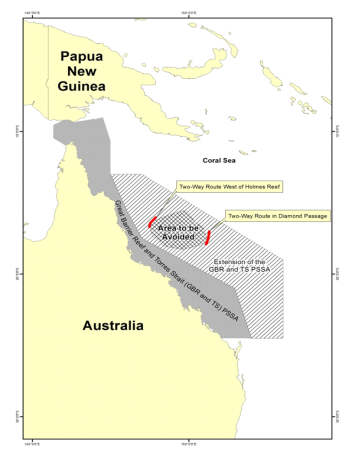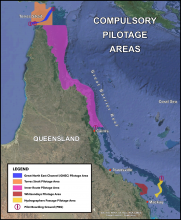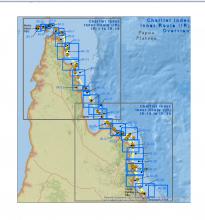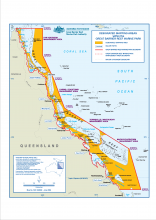The safety of shipping depends on you having detailed knowledge of, and complying with, regulatory and other obligations and duties we set out according to our legislation.
Navigation and safety
This quick guide highlights your key obligations when transiting through the Great Barrier Reef and Torres Strait. Keep in mind, it does not contain all of the regulatory and other obligations you and your crew will be subject to.
- Particularly sensitive sea areas
In 1990, the Great Barrier Reef became the world’s first particularly sensitive sea area (PSSA) designated by the International Maritime Organization.
The area was extended to include the Torres Strait in 2005 and extended again to an area of the south-west Coral Sea in 2015..
PSSAs allow additional protection measures such as ship routeing systems to be applied to vessels that transit the region.

- Coastal pilotage
Vessels with an overall length of 70 metres or more, and all loaded oil tankers, chemical carriers and liquefied gas carriers—irrespective of length—are required to use the services of a licensed coastal pilot in these compulsory coastal pilotage areas:
- Inner route (from Cape York to Cairns)
- Great North East Channel
- Torres Strait
- Hydrographers Passage
- Whitsundays
Masters are not relieved of overall responsibility for the safe operation of a vessel due to the presence of a pilot onboard.

Read more about coastal pilotage.
There are two marine notices for coastal pilotage:
- Queensland coastal passage plan
The Queensland coastal passage plan (QCPP) has been developed for the benefit of vessels transiting the region.
The QCPP improves the preparedness of ships transiting the Great Barrier Reef and Torres Strait pilotage areas by making sure that voyage plans, waypoints and other planing considerations have been completed in a standardised manner.
You are encouraged to prepare your voyage plans using the QCPP.

Read more about the Queensland coastal passage plan.
There are two marine notices for the passage plan:
- Great Barrier Reef and Torres Strait Vessel Traffic Service
The Great Barrier Reef and Torres Strait Vessel Traffic Service (REEFVTS) was established in 2004 as a mechanism to improve the safety and efficiency of vessel movements and to help protect the marine environment.
REEFVTS is operated by Maritime Safety Queensland (MSQ) from their VTS Centre in Townsville.
Information regarding the mandatory requirements for ships transiting the VTS area and the services provided is available from the Marine Safety Queensland website.
- Great Barrier Reef marine park designated shipping area
Vessels may only navigate within the designated shipping area (DSA) or the general use zones of the Great Barrier Reef marine park.
To navigate outside of the areas, a permit must be obtained from the Great Barrier Reef Marine Park Authority (GBRMPA).
More information on the DSA is available from GBRMPA and is provided in the Seafarers Handbook for Australian waters (AHP20). This publication should be carried when navigating in Australian waters.

Read more about the Great Barrier Reef marine park designated shipping area.
- Defect and incident reporting
You are required to comply with ship safety and the International Convention for the Prevention of Pollution from Ships (MARPOL) reporting requirements. This includes reports of the following events and events that could have resulted in:
- incidents, including:
- death or serious injury to a person
- collision, grounding or loss of a vessel
- loss of a person from the vessel
- fire, structural failure, flooding or machinery failure on board
- loss of cargo of a vessel
- dangers to navigation
- incidents involving failure of ships material handling equipment or injury to any person when engaged in cargo work
- MARPOL reporting for harmful substances or marine pollutant.
Find out more about how to report an incident.
When reporting an incident, you may need one or more of the following forms:
- incidents, including:
- Disposal of garbage
Discharge of all garbage including cargo residues is prohibited within the Great Barrier Reef and the Torres Strait.
This is because the nearest land boundary extends around the outer edge of the Great Barrier Reef and the Torres Strait.
Discharges permitted under MARPOL must be measured seaward of this boundary.
Read more about the disposal of garbage.
Read more in our fact sheet about managing solid bulk cargo residues in Australian waters PDF267.07 KB.
- Charts and publications
Relying on unofficial charts demonstrates inadequate voyage planning under a ship's safety management system. It may also indicate that a ship may be in an unfit state for the voyage, or poses a threat to the environment.
We will detain vessels that do not carry adequate and up-to-date nautical charts. This media release gives you an example of such a detention.
Current and official nautical charts and publications may be obtained from the Australian Hydrographic Service.
There are two marine notices for charts and publications:
- Fitness for duty
You have an obligation to make sure the watchkeeping arrangements on board comply with international convention requirements and that regulation 2.3 of the ILO MLC requirements are met for all seafarers on board the vessel.
Port State control inspections will include checks for compliance with the records of work and rest, and other on board documents.
We will issue deficiencies and detentions due to identified issues with work hours. These broadly fall within these categories:
- hours of rest not being complied with in port resulting in watchkeeping personnel on duty for departures and first sea watches not being adequately rested
- records of hours of work/rest not being maintained
- records of hours of work/rest not reflecting actual working arrangements
- deficiencies in the safety management system of the ship that hinder compliance
There are two marine notices for fitness for duty:
You might also find the 2006 Maritime Labour Convention Guide useful.
- Port State control
Through port State control (PSC) inspections, we monitor and enforce compliance of ships in Australian waters with internationally agreed standards for seaworthiness, safety and pollution prevention.
Read more about port State control.
- North East shipping management plan
With shipping movements in Australia's north east region expected to grow, the North East shipping management plan (NESMP) has been jointly developed by Queensland and other Australian government agencies in conjunction with industry and key interest groups.
Read more about the North East shipping management plan.
- Collision with cetaceans
Collision with cetaceans (whales, dolphins and porpoises) is a growing concern. Ship strikes can increase the risk of death and injury to animals, and damage property.
Humpback whales are present in the Great Barrier Reef region from May to September.
Under the Environment Protection and Biodiversity Conservation Act 1999 , all cetaceans are protected in Australian Commonwealth waters (generally between 3 and 200 nautical miles from the coastline). The legislation applies to all vessels.
If a vessel collides with a cetacean in Australia’s Commonwealth waters, the person in charge of the vessel is required by law to notify the Department of the Environment.
Ship masters and watch-keeping officers are urged to:
- maintain a good look out
- warn other vessels in the vicinity if whales have been sighted, using all appropriate means of communication
- consider reducing vessel speed in areas where whales have been sighted
- consider modest course alterations away from sightings.
Read more about reporting a ship strike.
Read more information on collisions between vessels and marine fauna.
You might find the IMO's guidance document for minimising the risk of ship strikes with cetaceans PDF147.96 KB useful.
- Queensland firefighting foam discharge requirements
International ships arriving in Australian waters are not allowed to use firefighting foams containing persistent compounds in Queensland state waters. Persistent compounds include aqueous film forming foam (AFFF) and fluoro-protein foams.
These requirements were introduced by the Queensland Government to protect safety of life at sea.
Read the Queensland Department of Environment and Heritage Protection for more information on:
- your regulatory obligations for firefighting foam use in Queensland state waters
- requirements for the treatment and disposal of wastes.